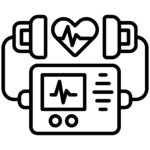The traditional healthcare landscape, characterized by in-person consultations, paper-based records, and manual processes, has long been fraught with inefficiencies and limitations. Patients often face long wait times, limited access to specialists, and fragmented care, while healthcare providers grapple with administrative burdens and challenges in coordinating care. These limitations have highlighted the urgent need for innovation and improvement in healthcare delivery.
Enter technology. Technological advancements are revolutionizing the healthcare industry, driving profound changes that enhance the quality, accessibility, and efficiency of care. From telemedicine and artificial intelligence to wearable devices and electronic health records, technology is transforming how healthcare is delivered and experienced. This article explores the key areas where technology is making a significant impact, the benefits it brings, and the challenges that must be addressed to fully realize its potential.
Key Areas of Transformation
A. Telemedicine and Virtual Care
The rise of telemedicine represents one of the most significant shifts in healthcare delivery. Telemedicine leverages digital communication tools to provide clinical services remotely, breaking down geographical barriers and expanding access to care. Patients can consult with healthcare providers via video calls, receive diagnoses, and even get prescriptions without leaving their homes.
Virtual consultations offer numerous benefits, including reduced travel time and costs, increased convenience, and quicker access to specialists. Remote monitoring tools, such as wearable devices and mobile apps, enable continuous tracking of vital signs and health metrics, allowing for timely interventions and personalized care. E-prescriptions streamline the medication management process, reducing the risk of errors and improving patient adherence to treatment plans.
B. Artificial Intelligence (AI) and Machine Learning (ML)
Artificial Intelligence (AI) and Machine Learning (ML) are transforming healthcare by enhancing diagnostic accuracy, optimizing treatment plans, and accelerating drug discovery. AI algorithms can analyze vast amounts of medical data to identify patterns and predict disease outcomes with remarkable precision. In diagnostics, AI-powered imaging tools can detect abnormalities in medical images, such as X-rays and MRIs, often more accurately than human radiologists.
In treatment planning, AI helps personalize care by analyzing patient data to recommend tailored treatment options. For instance, AI can predict how patients will respond to different therapies, enabling more effective and targeted interventions. In drug discovery, AI accelerates the identification of potential drug candidates by analyzing biological data and predicting molecular interactions, significantly reducing the time and cost of developing new medications.
C. Wearable Technologies and Remote Patient Monitoring
Wearable technologies, such as fitness trackers, smartwatches, and biosensors, are becoming increasingly popular for health monitoring. These devices track various health metrics, including heart rate, physical activity, sleep patterns, and blood glucose levels. By continuously collecting and analyzing health data, wearables empower individuals to take proactive steps in managing their health and wellness.
Remote patient monitoring, enabled by wearable devices, plays a crucial role in preventative care and chronic disease management. For patients with conditions such as diabetes, hypertension, or heart disease, continuous monitoring allows for timely adjustments in treatment plans and early detection of potential complications. This approach not only improves patient outcomes but also reduces the need for frequent hospital visits and readmissions.
D. Robotics and Minimally Invasive Surgery
Robotic technology is revolutionizing surgical procedures, making them more precise, less invasive, and safer. Robotic-assisted surgery allows surgeons to perform complex procedures with enhanced precision and control through small incisions. The use of robotic systems, such as the da Vinci Surgical System, has become increasingly common in various surgical specialties, including urology, gynecology, and cardiology.
The benefits of robotic surgery include reduced blood loss, shorter hospital stays, faster recovery times, and lower risk of complications. These advantages result in better patient outcomes and overall satisfaction. Additionally, robotic technology facilitates minimally invasive techniques, which are associated with less pain and quicker recovery compared to traditional open surgery.
E. Electronic Health Records (EHRs) and Data Analytics
Electronic Health Records (EHRs) are digital versions of patients’ medical histories, providing a comprehensive and accessible view of patient information. EHRs streamline the documentation process, improve care coordination, and enhance communication among healthcare providers. By consolidating patient data in a single, secure location, EHRs reduce the likelihood of errors and ensure that critical information is readily available when needed.
Data analytics, powered by EHRs, enable healthcare providers to gain insights into patient populations, identify trends, and make data-driven decisions. Advanced analytics can predict disease outbreaks, optimize resource allocation, and personalize care plans based on individual patient data. This data-driven approach enhances the quality and efficiency of healthcare delivery, ultimately leading to better patient outcomes.
The Impact of Technology
A. Improved Patient Outcomes
Technology significantly contributes to improved patient outcomes by facilitating earlier diagnoses, more effective treatments, and better communication between patients and providers. For example, AI-powered diagnostic tools can detect diseases at an early stage, when they are more treatable. Wearable devices and remote monitoring enable continuous health tracking, allowing for timely interventions and personalized care.
Enhanced communication tools, such as telemedicine platforms and patient portals, improve patient engagement and adherence to treatment plans. Patients can easily access their health information, communicate with their healthcare providers, and receive timely reminders for medications and follow-up appointments. This level of engagement and transparency fosters a collaborative approach to healthcare, ultimately leading to better health outcomes.
B. Enhanced Accessibility of Care
Technology overcomes geographical barriers and enhances the accessibility of care, particularly for individuals in remote or underserved areas. Telemedicine enables patients to receive medical consultations and follow-up care without the need to travel long distances. This is especially beneficial for those with mobility issues, chronic conditions, or limited access to healthcare facilities.
Remote patient monitoring and virtual care solutions also extend healthcare services to patients’ homes, reducing the burden on healthcare facilities and improving convenience for patients. By making healthcare more accessible, technology ensures that more individuals receive timely and appropriate care, regardless of their location.
C. Personalized Medicine and Precision Healthcare
Advancements in technology are driving the shift towards personalized medicine and precision healthcare. By leveraging AI, ML, and data analytics, healthcare providers can tailor treatment plans to individual patients based on their genetic makeup, lifestyle, and health history. Personalized medicine aims to provide the right treatment to the right patient at the right time, improving the efficacy and safety of interventions.
For instance, pharmacogenomics uses genetic information to predict how patients will respond to specific medications, enabling more precise prescribing and reducing the risk of adverse drug reactions. Precision healthcare also involves the use of advanced imaging and molecular diagnostics to identify disease subtypes and develop targeted therapies, offering a more customized approach to treatment.
Challenges and Considerations
A. Data Privacy and Security Concerns
As healthcare becomes increasingly digitized, protecting patient health information is paramount. The widespread use of EHRs, wearable devices, and telemedicine platforms generates vast amounts of sensitive data that must be safeguarded against breaches and unauthorized access. Ensuring data privacy and security requires robust cybersecurity measures, strict access controls, and compliance with regulations such as the Health Insurance Portability and Accountability Act (HIPAA).
Healthcare organizations must also educate patients about data privacy practices and obtain informed consent for data collection and use. Balancing the benefits of technology with the need for data protection is essential for maintaining patient trust and ensuring the ethical use of health information.
B. Digital Divide and Access to Technology
While technology offers numerous benefits, there are challenges related to equitable access. The digital divide refers to the gap between those who have access to digital technologies and those who do not. Factors such as socioeconomic status, geographic location, and education level can impact individuals’ ability to access and use technology-driven healthcare solutions.
Addressing the digital divide requires targeted efforts to improve digital literacy, expand internet access, and provide affordable devices and services. Ensuring that all individuals, regardless of their circumstances, can benefit from technological advancements in healthcare is crucial for achieving health equity.
C. The Human Factor and Ethical Implications
Despite the transformative potential of technology, the human factor remains a critical component of healthcare. Human expertise, empathy, and judgment are essential in providing holistic and patient-centered care. Technology should complement, not replace, the human touch in healthcare.
Additionally, the use of AI and other advanced technologies raises ethical considerations. For example, AI algorithms may perpetuate biases present in the data they are trained on, leading to inequitable outcomes. Ethical guidelines and oversight are necessary to ensure that AI and other technologies are used responsibly and transparently, with a focus on fairness and patient well-being.
Conclusion
Technology is undeniably transforming the healthcare industry, driving improvements in patient outcomes, accessibility, and personalized care. Telemedicine, AI, wearable devices, robotic surgery, and EHRs are revolutionizing how healthcare is delivered and experienced. However, to fully realize the potential of these advancements, challenges related to data privacy, equitable access, and ethical use must be addressed.
The future outlook for technology in healthcare is promising, with ongoing innovations poised to further enhance the quality and efficiency of care. By embracing technology while upholding ethical standards and ensuring equitable access, the healthcare industry can continue to evolve and meet the needs of patients in an increasingly digital world.
FAQs: How Technology is Transforming the Healthcare Industry
Q1: What are the main ways technology is transforming healthcare?
A1: Technology is transforming healthcare through telemedicine, artificial intelligence (AI), wearable devices, robotic surgery, and electronic health records (EHRs). These advancements improve patient outcomes, enhance accessibility, and enable personalized care.
Q2: How does telemedicine benefit patients and healthcare providers?
A2: Telemedicine benefits patients by providing convenient access to medical consultations, reducing travel time, and allowing for remote monitoring and e-prescriptions. For healthcare providers, it expands their reach, optimizes scheduling, and improves patient engagement.
Q3: What roles do AI and machine learning play in healthcare?
A3: AI and machine learning improve diagnostic accuracy, optimize treatment plans, and accelerate drug discovery. They analyze vast amounts of medical data to identify patterns, predict disease outcomes, and recommend personalized treatment options.
Q4: How do wearable technologies and remote patient monitoring improve healthcare?
A4: Wearable devices track health metrics like heart rate and activity levels, enabling continuous monitoring and proactive health management. Remote patient monitoring helps manage chronic diseases, detects potential issues early, and reduces the need for frequent hospital visits.
Q5: What are the advantages of robotic-assisted surgery?
A5: Robotic-assisted surgery offers greater precision, reduced blood loss, shorter hospital stays, faster recovery times, and lower risk of complications. It enables minimally invasive techniques, leading to better patient outcomes.
Q6: Why are electronic health records (EHRs) important in healthcare?
A6: EHRs provide a comprehensive digital record of patient health information, improving care coordination, reducing errors, and enhancing communication among healthcare providers. They also enable data analytics for better healthcare delivery and personalized care plans.
Q7: How does technology improve patient outcomes?
A7: Technology facilitates earlier diagnoses, more effective treatments, and better communication between patients and providers. It enables continuous health monitoring, timely interventions, and personalized care, leading to improved health outcomes.
Q8: What challenges are associated with technology in healthcare?
A8: Key challenges include data privacy and security concerns, the digital divide and equitable access to technology, and ethical considerations related to AI use. Addressing these challenges is essential for maintaining patient trust and ensuring fair use of technology.
Q9: How can the digital divide be addressed in healthcare?
A9: Addressing the digital divide involves improving digital literacy, expanding internet access, and providing affordable devices and services. Ensuring equitable access to technology-driven healthcare solutions is crucial for achieving health equity.
Q10: What ethical considerations arise with the use of AI in healthcare?
A10: Ethical considerations include ensuring AI algorithms do not perpetuate biases, maintaining transparency in AI decision-making processes, and balancing the use of technology with the need for human expertise and empathy in patient care.
 Hospital Furniture
Hospital Furniture Medical Devices
Medical Devices MSR Products
MSR Products Office Furniture
Office Furniture